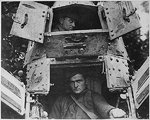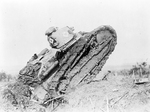FT-17
| Country | France |
| Manufacturer | Renault S.A. |
| Primary Role | Light Tank |
Contributor: C. Peter Chen
ww2dbaseThe FT 17 light tanks were designed by Rodolphe Ernst-Metzmaier of the French manufacturing firm Renault in the few months of 1917. Early production models suffered from radiator fan belt and cooling system problems, but the 2,697 tanks delivered before the end of WW1 became some of the most advanced tanks of the period as the first tanks with fully rotating turrets and other modern characteristics. 514 of them were delivered to the United States and three to Italy for use in WW1; the French Army operated about 2,600-3,000 units. During the inter-war years, they were widely exported; countries purchasing them included Poland, Finland, Russia, Czechoslovakia, Spain, China, Japan, and several others. They participated in many major conflicts such as the Russian Civil War, Polish-Soviet War, the Chinese Civil War, and the Spanish Civil War. When WW2 began, they were still in service in Poland, Finland, France, and Yugoslavia. When Germany invaded France in 1940, eight battalions and three independent companies operated a total of 534 FT 17 light tanks, with at least 1,000 units kept in reserve (some of which were assigned to newly-formed tank crews during the invasion). These near-obsolete tanks fought alongside of modern French tanks, and when France capitulated, 1,704 FT 17 light tanks were captured by the German forces; the German Army placed about 100 units into service for airfield defense and assigned about 650 units to occupation forces across Europe.
ww2dbaseSource: Wikipedia.
Last Major Revision: Apr 2009
SPECIFICATIONS
FT-17
| Machinery | One Renault 4-cylinder gasoline engine rated at 39hp |
| Suspension | Vertical springs |
| Armament | 1x37mm machine gun or 1x7.92mm machine gun |
| Armor | 22mm |
| Crew | 2 |
| Length | 5.00 m |
| Width | 1.47 m |
| Height | 2.14 m |
| Weight | 6.5 t |
| Speed | 7 km/h |
| Range | 65 km |
Photographs
 |  |
Please consider supporting us on Patreon. Even $1 per month will go a long way! Thank you. Please help us spread the word: Stay updated with WW2DB: |
Visitor Submitted Comments
27 Jul 2013 07:00:19 AM
In 1941, as a result of Hitler's order to send armour to the Channel Islands, Field Marshal von Witzleben despatched twenty Renault FT-17/18 tanks to the garrison. The largest islands of Guernsey and Jersey received eight tanks each with four others being shipped to Alderney. When Absteilung 213 arrived in the Channel Islands in March 1942 the Renaults were handed over to the infantry for airfield defence use. By the end of 1944 only two remained serviceable. The others having been cannibalised for parts after which the immobilised tanks were turned into static airfield pillboxes.
All visitor submitted comments are opinions of those making the submissions and do not reflect views of WW2DB.

- » Wreck of Teruzuki Found (27 Jul 2025)
- » USS Orlean's Bow Found (22 Jul 2025)
- » The Emperor of Japan Planned to Honor WW2-era Japanese POWs in Mongolia (4 Jul 2025)
- » US State Lawmaker John Winter Caught Using Racial Slur "Jap" and Apologized (11 Jun 2025)
- » US Government Plans to Purge WW2 Information (17 Mar 2025)
- » See all news
- » 1,182 biographies
- » 337 events
- » 45,119 timeline entries
- » 1,248 ships
- » 350 aircraft models
- » 207 vehicle models
- » 376 weapon models
- » 123 historical documents
- » 261 facilities
- » 470 book reviews
- » 28,409 photos
- » 365 maps
Winston Churchill, on the RAF
5 Nov 2009 11:43:22 AM
By the end of World War I the French built
over 3,000 Renault FT-17's. Production was
continued and other countries bought the tank
However, by the start of World War II, the
French had 2,500 FT's at the time of the German invasion.
The Renaults were antiquated, and stood no
chance against the German Panzer's. Many were
lost in one-sided battles.
The Germans captured large numbers and used
them for security duties,others were rebuilt as ammunition and supply carriers, other's
rebuilt into one-of-a kind vehicles.